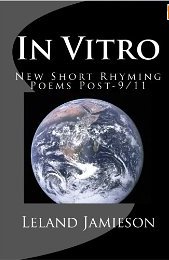
As in his earlier book, Twentieth Century Bread, in In Vitro: New Short Rhyming Poems Post-9/11, poet Leland Jamieson paints a vivid landscape using rhyme and diction. A formal poet by nature, his best efforts are tightly-crafted examples of form meeting function. With his verse, he explores childhood memories, extols the beauty of nature, and contemplates the history of human life on earth.
Jamieson’s poems about his youth are often sprawling but packed with detail, such as in the sestina “Sunshine,” where he begins with a compelling image:
My cousin Jack and I, arms out for balance,
toed still-warm rails. Our blue jeans’ pockets carried
great rusty spikes (one each) that we bent double
plucking from ties. I couldn’t catch my figure,
stilts-like, racing east in setting sunshine,
lashing the rails no end with skinny shadows…
In addition to retelling childhood stories, he turns a poet’s eye to even the most mundane activities, such as throwing away the ashes from a wood fire. In “Ashes,” he writes:
I can’t just throw away, and waste, the gray
wood ashes flecked with charcoal chunks that fall
down through our Jøtul’s grate, their flame’s ballet
too cool at core to dance the night’s short haul.
When cold, I dump them in our woods. They sprawl,
volcanic cones upon a sea of snow.
In a perfect example of how sometimes quirkier language undermines what comes before or after, the next line is “(Oak-acid soil cries out, ‘Please sweeten — Yo!’)”
Then again, too few poets demonstrate a sense of humor, a willingness to toss aside a serious tone and instead, just laugh at themselves. In “Frontiers,” Jamieson pokes fun at growing older:
We used to wonder why most older folks
in restaurants talked so little during meals.
Now we’ve turned older, and we find the joke’s
on us. It’s hard to hear.
No topic is too small — or too lofty — for Jamieson, who is equally comfortable examining shells or pondering the celestial origins of humans. As he did in 20th Century Bread, he includes several poems about the Anunnaki space travelers who, according to an ancient Sumerian manuscript, influenced life on Earth. In this collection, however, he does a better job of explaining the sources for these stories, in the notes at the back of the book. Perhaps, in order to make that series of poems more accessible for those who fail to read the notes, such a plain retelling needs to appear in a poem, as well.
Overall, Jamieson’s collection is a thoughtful, careful examination both of one person’s life experiences and about the nature of life experiences in general.

